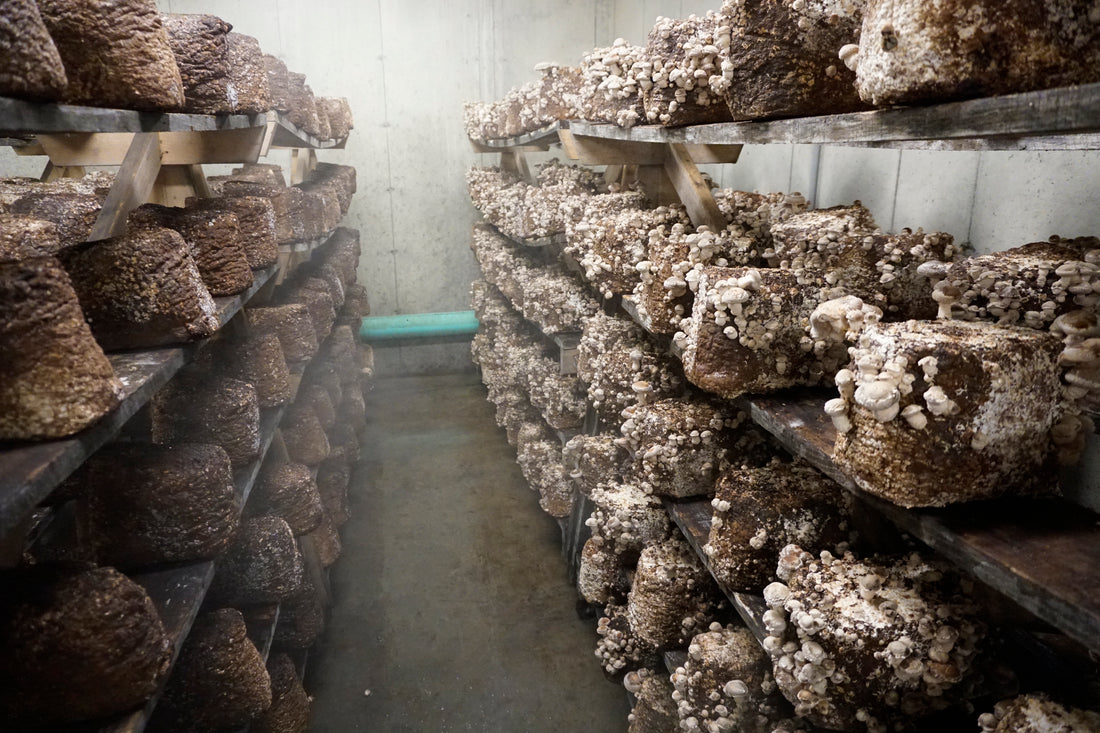A Research and Education project funded by Northeast SARE to help more farmers grow mushrooms
WATCH THE FIRST WEBINAR HERE
WATCH THE SECOND WEBINAR HERE
WATCH THE THIRD WEBINAR HERE
This project focuses on three systems of cultivation for growing mushrooms:- Oyster mushroom cultivation on straw.
- Specialty mushroom production on ready-to-fruit blocks indoors.
- Specialty mushroom production on ready-to-fruit blocks outdoors.
Download Book 1 on Specialty Mushrooms and Book 2 on commercial mushroom production And Book 3 on Starting a Specialty Mushroom Farm
Growers will offer a range of scenarios that will be described in case studies and enterprise budgets, which will be published along with a finalized cultivation manual. All materials will be available indefinitely online here and through the SARE website. Performance target: 300 farmers attend in person trainings. 100 attend the 3 week webinar series to learn methods of cultivating specialty mushrooms. 30 apply to receive assistance growing 30 pounds of mushrooms per week. 10 growers produce and sell 9,000 pounds over 30 weeks, generating $108,000.MILESTONES FOR BENEFICIARY LEARNING IN GROWING MUSHROOMS
Milestone 1: 1000 vegetable and beginning farmers in the Northeast learn about specialty mushroom cultivation as a viable farm enterprise through webinars, newsletters, and emails. April – August 2019.
Milestone 2: Initial training on growing mushrooms and record keeping materials are developed. April – August 2019
Milestone 3: 300 farmers attend trainings (30 participants at 10 events) facilitated by growers and educators in New York, New Hampshire, Massachusetts, Vermont, Pennsylvania, Rhode Island, and Maine. Workshops cover cultivation techniques, business planning, and project performance target. October – January 2020.
Milestone 4: 100 farmers attend three 2-hour webinars providing in-depth training on specialty cultivation methods; fruiting room design and maintenance; and expected hours, expenses and income to produce 20-50 pounds of mushrooms a week. February 2020.
Milestone 5: 15 farmers submit a basic plan and budget for a system to produce 30 pounds of specialty mushrooms per week for 30 weeks between April and December. March 2020.
Milestone 6: 10 Farmers produce 9,000 pounds of mushrooms generating $108,000 of added income and receive ongoing support with the project team by phone, email, and a group discussion board. Site visits are arranged with participating growers. Data on expenses, sales, and labor inputs is collected by growers and reviewed monthly by project team. April – December 2020. Milestone 7: 10 participating farmers submit final production, yield and quality data. December 2020.
Milestone 8: Data is analyzed and informs an enterprise budget tool. Case studies of selected farms are written and published. Guidebook is finalized with data incorporated from the project and is published online and distributed to 5,000 people through Facebook, listservs, and newsletters. May 2021.
This project is available for the following states: CT, ME, NH, VT, MA, NY, PA, NJ, NY, DE, MD, RI, WV, DC
Growing Mushrooms Booklet Series
This series of booklets on growing mushrooms is intended to support any farmer, student, educator, organizer, entrepreneur or homesteader who is interested in taking specialty mushroom cultivation to the community level. This first booklet provides an introduction to mushrooms, mycology, and the specialty mushroom industry. We also discuss the ways mushrooms offer solutions to a wide range of community challenges in both rural and urban locations.
Book Two on growing mushrooms provides a detailed overview of common cultivation methods, and the third book discusses the parameters for fruiting, harvest, and sales. While the overall intention of these guides is to support cultivators to get started or improve a commercial operation, the information and methods offered here also apply to anyone interested in mushroom production at many other scales. Mushrooms have so much to teach us beyond reusing waste streams and producing high-quality food. They are also teachers of the connection all beings share, the importance of community, and the truth that nothing goes to waste.
Yes, the specialty mushroom industry is rapidly growing, and there a re huge business opportunities in working with fungi. This should not supersede the deeper truths fungi have to teach. Hopefully as this industry expands it can do so with the values of community and connection. The best teachers for growing and working with fungi are the mushrooms themselves. A lot of learning how to cultivate mushrooms is trying to grow them, watching what happens, and then adjusting accordingly.
re huge business opportunities in working with fungi. This should not supersede the deeper truths fungi have to teach. Hopefully as this industry expands it can do so with the values of community and connection. The best teachers for growing and working with fungi are the mushrooms themselves. A lot of learning how to cultivate mushrooms is trying to grow them, watching what happens, and then adjusting accordingly.
 re huge business opportunities in working with fungi. This should not supersede the deeper truths fungi have to teach. Hopefully as this industry expands it can do so with the values of community and connection. The best teachers for growing and working with fungi are the mushrooms themselves. A lot of learning how to cultivate mushrooms is trying to grow them, watching what happens, and then adjusting accordingly.
re huge business opportunities in working with fungi. This should not supersede the deeper truths fungi have to teach. Hopefully as this industry expands it can do so with the values of community and connection. The best teachers for growing and working with fungi are the mushrooms themselves. A lot of learning how to cultivate mushrooms is trying to grow them, watching what happens, and then adjusting accordingly.As with any farming venture, it is key to accept that you will have both successes and failures. Mushroom cultivation is a constant dance of observation and reaction, of science and art. Hopefully these booklets give you a beat to start that dance, to explore with curiosity who fungi are and how to ally with them in your life.
This is the second booklet in a series designed to introduce growers to the wide world of specialty mushroom cultivation. While book one focused on an overview of what mushrooms are and the outlook of the industry as a whole, this booklet outlines the considerations to successfully bring mushrooms through the production cycle in a commercial context. Book three focuses on the construction of sound growing spaces, considerations for marketing and sales, as well as grower profiles. If you have not read book one yet we recommend starting there!
To join the project on growing mushrooms or get further details email willie@fungially.com
Growing Mushrooms Using Supplemented Sawdust Blocks – Indoors
Indoor mushroom production on supplemented sawdust blocks (referred to in this section as “blocks”) is the largest scale method for specialty mushroom production. This method allows for fast cropping cycles with high yields. Indoor block production allows for precise environmental controls and year round production. This method also means that management of the crop intensifies, and costs like rent, infrastructure, and materials increase.If a farm is being developed as a large scale mushroom farm, it makes sense to produce mushrooms using this method. Indoor fruiting typically means creating a fruiting environment inside of another building or existing structure. Basements of houses, barns, trailers, and warehouses are all viable options for indoor fruiting. One major advantage of indoor fruiting is the flow of production. A farm can be designed to include handling/treatment, lab, incubation, fruiting, storage and shipping areas all in a single flowing building.
On a large scale, above 300 pounds per week, this becomes critical; on small scales little inefficiencies can be annoying but won’t make or break the operation. Creating an indoor fruiting room will be covered in greater detail in the next booklet on growing mushrooms.
There are three options you can explore to procure sawdust blocks:
- Create a lab and produce the blocks in-house. This does require a considerable amount of space, up front cost, and training.
- Purchase the blocks new from another company or local mushroom farm. Take the lab work out of it and start by buying the blocks in. A walk-in cooler and cash flow of about $7,000 is needed for growing about 150 pounds per week.
- Purchase second-flush blocks from a local mushroom farm, instead of new blocks, which typically cost between $5-7.50; second flush blocks can be sold by the truckload or $1/block. Yields will be much lower and sporadic, but if cash flow is an issue this is a great way to start out growing mushrooms. Additionally, over the course of a year these blocks will turn into incredible soil, so there is both an investment in the mushrooms as well as building organic matter and soil life on the farm.
Growing Mushrooms Using Supplemented Sawdust Blocks – Outdoors
Outdoor fruiting on supplemented sawdust blocks is one of the easiest methods to start growing mushrooms. Very little infrastructure or space is needed to successfully grow mushrooms outdoors. Several different species including shiitake, lions mane, chestnut, and pioppino can easily be fruited from blocks outside. Since these blocks are ready to fruit, they can be used for growing mushrooms outdoors from April-November in northern climates.
Note: It is not recommended to grow oyster mushrooms in this fashion as they get larvae in them when grown outside.
Depending on how the sawdust blocks are procured and what method of shocking is used, the outdoor fruiting area will look a little different. This process can be as easy as putting blocks in the woods and letting them fruit. Find a nice canopy of either deciduous or evergreens and clear away the dead organic material on the ground. Place the blocks directly on the soil with sufficient space between them to allow fruiting and mist 2-3 times per day for the first four days.
One issue that can come up is that the mushrooms fruiting at the bottom of the blocks can get a little dirty. To prevent this, simply place pallets down in the woods to lift the blocks out of the soil, so the mushrooms will stay clean even if it rains. A single 4’x4’ pallet can hold about fifteen 5lb blocks. To create the optimal conditions for growing mushrooms, particularly to increase humidity during the pinning process, install a low tunnel consisting of plastic or metal hoops and greenhouse plastic above the pallets. This allows the moisture to be held in and supports good mushroom pinning. Spraying with a hose once a day for the first 5 days of mushroom formation will create beautiful pin sets.
If you are soaking blocks, particularly 2nd flush blocks, green mold can become abundant if the exterior of the blocks are not allowed to dry before placing the plastic on the low tunnel. After soaking, allow the blocks to dry out for 12-24 hours and then place the plastic over the low tunnel. With 2nd flush blocks, sometimes it is easier to not manage them, but to let them fruit when the rains decide. Simply spread the blocks out on the forest floor and wait for the rain. If you wanted to try and force the blocks to fruit, you could run a sprinkler for 24 hours after they have sat for 3 weeks. Blocks that are fruiting for the 2nd and 3rd time produce beautiful mushrooms outdoors in the natural environment particularly in April/May and Sept/Oct during the cooler temperatures.
Even if indoor block production is the focus, a significant amount of mushrooms can be harvested from “spent” blocks outdoors, if they are visited after heavy rains.




